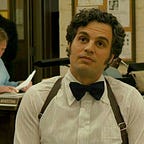A Look Back: “To The Wonder”.
Close your eyes and do your best impression of a Terrence Malick trailer. What do you see? Stalks of wheat blowing gently in the cruel country air? Or how about that same image, but intercut with some beautiful young waif running her slender hands along said wheat… oh, and all of this glimpsed in penetrating close-up, so close you can practically breathe it in. Let’s see… pirouetting shots of clouds in the sky? Wistful voiceover about the nature of all things cosmic and philosophical? Magic hour shots? Does all that sound about right?
Your best Malick impression probably isn’t far off from the director’s last film, a gorgeous, interesting and mostly infuriating experiment called “To the Wonder”. Malick has never, not in almost thirty years, made a film that I thought was anything less than a towering work of art. Now he has, but there’s a certainly lot to recommend along the way — probably more than the film’s many detractors would suggest. Malick’s scorching “Badlands” remains one of the most intensely haunting debuts in all of American cinema, and his deeply spiritual war picture “The Thin Red Line” somehow managed to find moments of entrancing beauty amidst the ghastly display of mankind destroying itself from the inside out. However often his pretensions get the best of him, the guy’s a true visionary, although one has to wonder if his newfound productivity (he released “To the Wonder” a mere two years after “The Tree of Life”, a neat and unusual feat for a filmmaker who was known to take decades between projects, and is set to release the Los Angeles-set “Knight of Cups” this year) is responsible for the nagging sense that “To the Wonder” is ultimately a collection of Malick B-sides rather than the great, majestic concept album that was “The Tree of Life”.
Indeed, “To the Wonder” often feels like an odds and ends collection: like scraps of random inspiration that were possibly cut from “The Tree of Life’s” rough early drafts. If “The Tree of Life” was a mystical exploration of life, death and what lies beyond our immediate frame of understanding, then “To the Wonder” examines romance and heartbreak with that same dreamy élan, although it’s less nakedly autobiographical than that earlier film, which may prove to be Malick’s enduring masterpiece. Tellingly, “To the Wonder’s” opening ten-minute stretch is by far its most arresting. Ben Affleck plays Neil, who, while on vacation in Paris, falls in love with a beautiful young woman named Marina. They frolic in the park, take the subway together, and pledge their undying love for one another. In one of the most sensually ravishing sequences of Malick’s career, the two star-crossed lovers travel to the icy, remote reaches of Mont St. Michel, where the barren, alien vibe of the landscape evokes the grand solitude of a foreign planet (before you say it, there are definitely shades of Antonioni’s “L’Avventura” here).
Neil later relocates his new lover and her 10-year old daughter to the country flatlands of Oklahoma, where the film settles on a more familiar, less satisfying tone (here come the endless shots of cornfields). Marina admires the earnestness with which these small town folks live their modest lives, but a part of her yearns for the cosmopolitan thrill of Europe, even as her daughter undergoes her own drastic and destabilizing period of adjustment. Rachel McAdams shows up as a woman from Affleck’s past and Javier Bardem does what he can with the part of a local Jesuit priest undergoing a crisis of faith. I know what you’re thinking — Javier Bardem? Doing what he can? In all fairness, it’s really not the actor’s fault: Bardem is one of our most versatile performers, and he’s almost never given a bad performance but asking the audience to believe this worldly, eloquent Spaniard is actually a humdrum man of God stationed a small Oklahoma town is a pretty big stretch by anyone’s standards. His relationship with the rest of the story never quite gels, even if you can see some of the overarching themes that must have attracted Malick to this particular subplot.
Like any Malick film, “To the Wonder” contains moments where the director seemingly re-writes the language of cinema before your very eyes. These are the moments that will cement the director’s legacy as one of the great visual artists of all time, and proof that he could work in no other medium than film itself. And yet it’s hard to stay invested in a movie where everyone communicates through opaque declarations (“What is this love that loves us so?”) rendered in whisper-y voiceover and where continuity is all but smashed to bits in favor of self-indulgent noodling. I’m all for saying “to hell” with plot, but only if you’ve got something more inventive than “Days of Heaven: Revisited” up your sleeve.
Affleck remains a durable and underrated leading man, but unlike Brad Pitt’s tough-ass dad in “The Tree of Life”, he’s not as capable at suggesting his character’s inner life without dialogue. But wait, you ask. What of the voiceover? I wish I knew what to tell you about that. It’s a shame, because “To the Wonder” is never anything less than interesting and occasionally even quite brilliant, despite the fact that it’s by far the director’s least successful film. It’s not that he’s lost his touch, and who’s to say that “Knight of Cups” won’t restore him to the peak of his powers? It’s just that “To the Wonder” too often feels less like a Terrence Malick film and more like a disjointed imitation of one.
